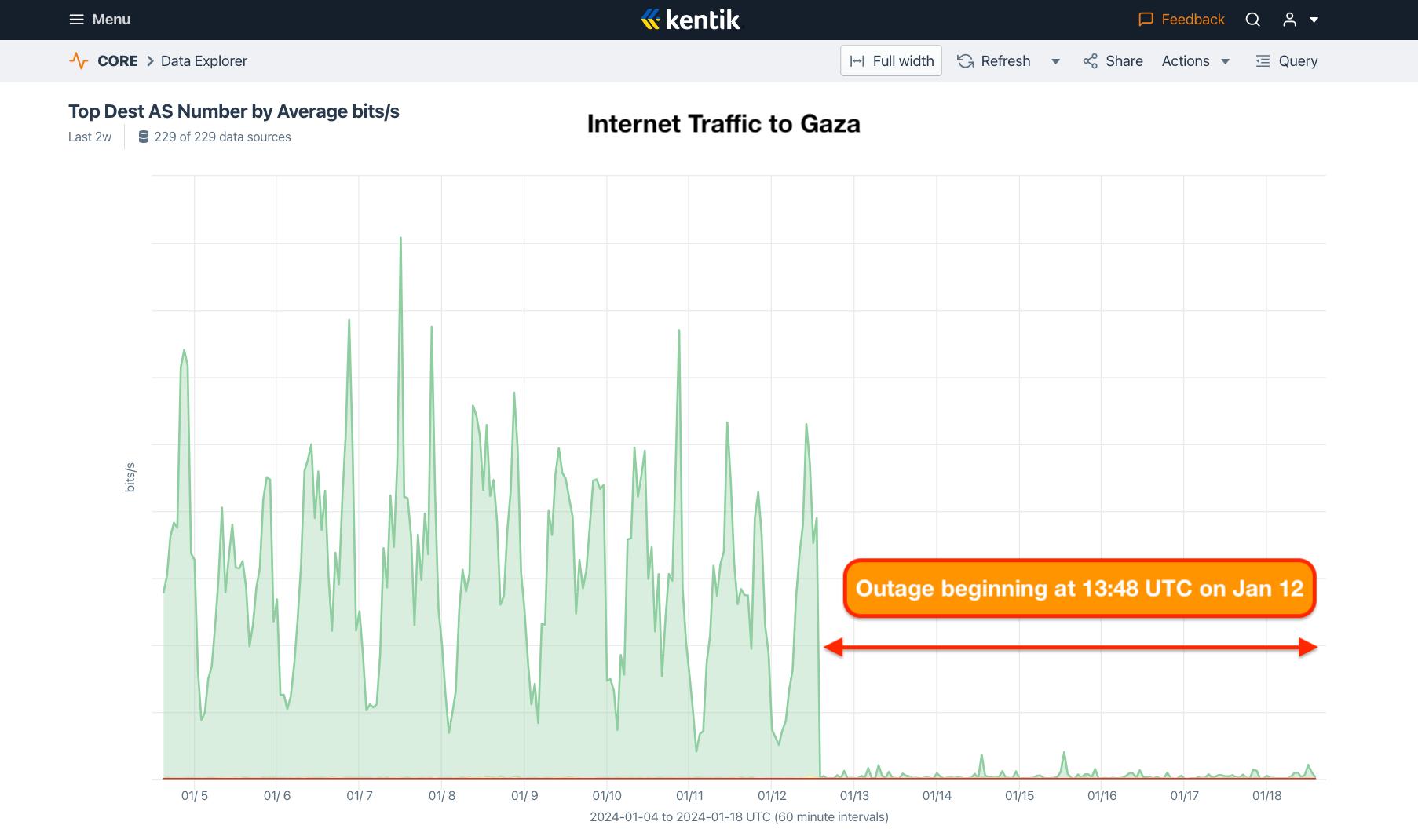Internet monitoring firms say a near-total internet blackout in Gaza is reaching its seventh day, the longest outage of the ongoing Israel-Hamas conflict so far.
Doug Madory, the director of internet analysis at Kentik, told TechCrunch in a Signal message that this is the “longest internet blackout ever and longer than all of the previous blackouts combined” in Gaza.

A graphic showing internet connectivity in Gaza. (Image: Kentik)
On January 12, Palestinian telecom giant Paltel announced that “all telecom services in Gaza Strip have been lost due to the ongoing aggression. Gaza is blacked out again.”
Paltel said that the shutdown is the result of damaged infrastructure in Khan Younis, a city in the south of the Gaza strip, according to The New York Times.
Early on Thursday, internet monitoring firm NetBlocks reported on X (previously Twitter) that its data showed an outage lasting 144 hours (six days) and counting, which lines up with the data collected by Kentik and Paltel’s public announcement. According to NetBlocks, this is the “ninth and longest sustained” telecom’s outage since the onset of the present conflict with Israel.
David Belson, the head of data insight at Cloudflare, which also monitors internet connectivity across the world, told TechCrunch on Thursday that there is an ongoing internet outage in Gaza.
When TechCrunch tried to reach out on a chat messaging app to a telecom engineer, who previously requested to remain anonymous to protect his safety, the message could not be delivered.
Nebal Farsakh, a spokesperson for the humanitarian organization Palestine Red Crescent Society, told TechCrunch that the internet blackout is impacting the organization’s efforts to aid the injured.
“People in Gaza are unable to call the 101 emergency line to get ambulances,” Farsakh said in an audio message. “And this is absolutely hindering the work of our ambulances and delaying their arrivals to the wounded people.”
A spokesperson for Israel Defense Forces did not respond to TechCrunch’s request for comment.
Hamas, designated as a terrorist organization by U.S. and U.K. governments, launched a surprise attack on October 7 targeting Israelis in their homes, killing at least 1,200 people. In the months following, Israeli military forces responded with retaliatory air strikes and a ground offensive in Gaza that have killed at least 22,000 people in the territory, according to recent data by Palestinian authorities.
Digital rights organization Access Now, which regularly campaigns against internet shutdowns across the globe, wrote in a press release that “documenting and sharing information about what is happening on the ground is increasingly challenging, if not outright impossible,” as a result of the outages.
Hisham Mhanna, a spokesperson for the International Committee of the Red Cross, told The Times that “when you try to plan for any mission during a blackout, you cannot predict the surprises or challenges that the team may face on their way — it’s hard to report back to our headquarters.”
“This is where it becomes dangerous,” said Mhanna.
Nazar Sadawi, a correspondent with Turkish Radio and Television who was working in Gaza as of the end of December, told The Nation magazine that the internet shutdowns have forced journalists to revert to traditional methods of reporting, such as walking between bombed areas, talking to survivors and witnesses to understand casualty numbers, and listening to the radio.
“The news that I used to get in three minutes I now get in an hour or two,” said Sadawi.
Updated with comment from Palestine Red Crescent Society. Corrected the number killed in Hamas’ attack on October 7 to at least 1,200 people, as confirmed by an Israel government spokesperson in November. This was due to an editor’s error. ZW
techcrunch.com




